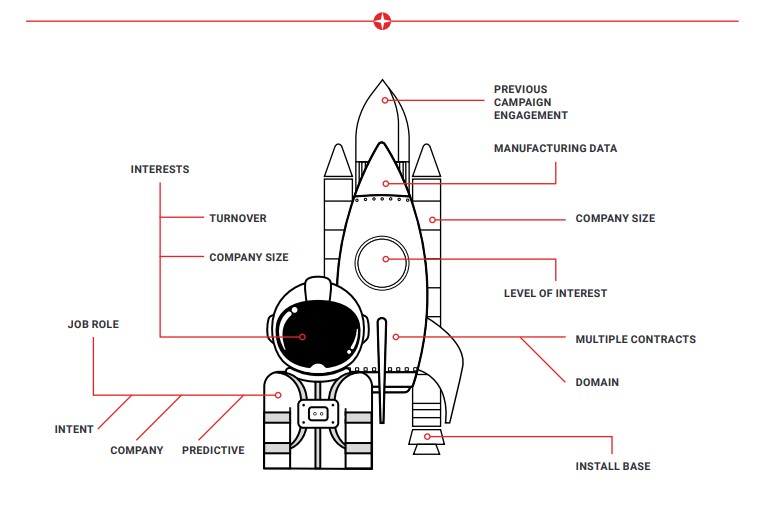Striking the right balance between lead quantity and quality is crucial. Despite the temptation to prioritize hitting MQL targets, the essence of impactful lead generation lies in the quality of leads. This focus not only streamlines the sales cycle but also maximizes efficiency, ensuring sales teams can dedicate their efforts to the most promising prospects.
While our previous article explores the importance of working out your optimum MQL lead volume to guarantee you hit revenue targets, this article builds upon that foundation by delving into the critical importance of defining B2B lead quality.
Understanding the significance of lead quality
Lead quality is determined by various factors, such as alignment with the Ideal Customer Profile (ICP), engagement level, and readiness to purchase. These criteria are crucial for driving conversions and maximizing efficiency in the sales process.
Criteria for assessing lead quality:
- Accurate information: Essential for effective sales engagement
- ICP fit: Alignment with your ideal customer profile increases conversion likelihood
- Engagement levels: Indicators of interest and purchase intent
- Lead source and score: Higher value arises from targeted sources and behavior-based scoring
- Sales qualification: Further validation of lead readiness
- Expressed interest: Direct inquiries signal strong potential
- Demographic factors: Geographic and budgetary alignment enhance lead relevance
- Immediate need & purchase timeline: Critical markers for sales prioritization
- Recurring business potential: Augments the lead’s lifetime value
- Technological assessment: Lead scoring systems provide a quantitative assessment of potential
How to define B2B lead quality (and its varying degrees):
Developing a holistic view of your ICP involves leveraging a broad range of first-party firmographic data points, including target industry, company size, turnover, and job title. While these characteristics establish a baseline of lead quality, assessing likelihood to convert requires additional insights.

Third-party buyer signals, such as purchase authority, active topic searches, and overall account activity, can significantly enhance lead profiles for predictive lead scoring. This approach aggregates data from both first and third-party sources to generate a numerical value that considers influence, engagement, and buyer stage, signaling the likelihood of a lead converting.
Ensuring a lead’s quality is assessed and scored correctly before being passed to sales is crucial for maintaining a high MQL to SQL conversion rate and reducing lead rejections, driving B2B Sales Acceleration.
Driving demand generation through high-quality leads
Research shows that 40% of senior B2B marketers underline lead quality as their focal point, underscoring its role in sustainable growth. When leads that perfectly match your ICP emerge, they not only expedite the sales process but also pave the way for establishing a loyal and profitable customer base.
The importance of lead quality
High-quality leads, characterized by readiness to purchase and familiarity with your offerings, generally exhibit higher conversion efficiencies. Addressing the challenge of generating such leads is fundamental. Moreover, according to HubSpot, just over 15% of sales teams highlight the lack of high-quality leads as a critical challenge they face. This underscores the integral role that quality leads play in ensuring the efficacy of sales strategies. Improved lead quality directly correlates with enhanced sales productivity and, by extension, significant revenue growth. It enables sales teams to concentrate on high-value deals, boosting overall performance.
Assessing and refining lead quality involves analyzing interaction data and employing lead-scoring mechanisms to focus on the most promising leads. This process not only optimizes marketing strategies but also fosters a cohesive operation between sales and marketing units, aligned towards collective success and growth.
How to measure lead quality
When it comes to measuring lead generation, there are several metrics you should track:
- Lead to opportunity conversion rate – What percentage of your leads are converting to marketing qualified or sales accepted opportunities? A higher conversion rate indicates better quality leads
- Sales acceptance rate – What percentage of leads passed to sales are accepted by the sales team? Higher rates indicate leads align with ideal customer profiles
- Lead response time – How quickly are leads responding to follow-ups and nurturing? Faster response times signal higher interest and engagement
- Lead score – Are you using lead scoring to grade incoming leads? Higher lead scores identify hot prospects worth prioritizing
- Buyer persona fit – Do leads match your ideal buyer personas? Good fit means they’re more likely to have pain points your solution addresses
- Lead to customer conversion rate – What percentage of leads ultimately become customers? Higher conversion rates mean you’re attracting quality leads primed to buy
Tools and techniques for lead quality measurement
To accurately measure lead quality, leverage tools like:
- CRM – Track lead stages, scores, and conversion rates right in your CRM. Add custom fields to capture more data
- Marketing automation – Grade leads in real-time, send automated nurture campaigns, and report on lead performance
- Web analytics – Analyze site visitor behavior to identify high-intent actions that indicate lead quality
- Surveys – Ask leads directly about pain points and evaluate responses to determine interest and fit
- Feedback forms – Capture feedback from sales on lead quality to refine definitions and improve alignment
Techniques like lead scoring, buyer persona mapping, and conversion rate optimization also optimize lead quality over time.
Key challenges in measuring lead quality for B2B marketers
Here are some of the biggest challenges facing marketers when measuring the quality of leads:
- Poor data quality and incomplete information
- Lead data often resides across different platforms, lacks uniform formatting, and is missing critical details such as lead source, timestamps, and visitor identification, thereby complicating a thorough quality assessment
- Manual data processes contribute to errors and missing behavioral indicators like page views and form submissions, skewing the analysis
- Lack of standardized processes
- The absence of uniform processes for lead qualification leads to inconsistent evaluations, disputes between teams on what constitutes a “sales-ready” lead, and ineffective lead handoff
- Without standardized procedures, there’s a lack of a unified strategy for nurturing and managing leads, which might result in overlooking potent leads while expending resources on less promising ones
- Inadequate use of technology
- Many companies still depend on outdated tools that are insufficient for capturing and analyzing complex lead data
- Insufficient implementation of modern CRM systems and advanced analytical tools hampers the depth of lead data analysis. The underutilization of AI and ML technologies prevents businesses from leveraging predictive analytics to identify the most promising leads
These challenges underscore the need for B2B marketers to adopt integrated data management systems, establish clear, standardized lead-handling processes, and equip their teams with advanced technological tools. By addressing these areas, businesses can enhance the precision of their lead quality assessments and optimize their sales strategies effectively.
What strategies can be adopted to improve lead quality?
Here are several strategies that can be adopted to enhance lead quality:
1. Optimizing lead generation channels
The foundation for improving lead quality lies in the optimization of your lead generation channels. This process entails refining your targeting criteria and segmentation, experimenting with various offers and messages, and reallocating budgets towards the most effective channels. Continuous analysis of lead generation outcomes is crucial. Focus on identifying which campaigns, advertisements, and landing pages yield the highest conversion rates. Invest in successful strategies and gradually eliminate those that underperform.
2. Lead scoring and qualification criteria
Adopting a formalized lead scoring system is essential for distinguishing high-quality leads. Assign scores to leads based on critical factors such as demographics, engagement behaviors, product interest, and content interaction. Establish baseline scores for MQLs and SQLs, facilitating efficient routing of leads for further action based on their scoring. Regularly refining your scoring model with incoming data ensures its relevance and effectiveness.
3. Ensuring data accuracy
The accuracy of lead data is paramount. Implement comprehensive validation processes to verify crucial contact details, such as email addresses and phone numbers. Periodic auditing and cleaning of your database are necessary to remove duplicate entries and outdated information, thereby enhancing the precision and reliability of your sales initiatives.
4. Intent data signals
Use intent data to gauge a lead’s readiness for purchase and level of interest. Analyzing digital footprints—such as website activity, content interaction, and social media engagement—reveals explicit indicators of buying intent. Prioritizing leads demonstrating strong purchase intent through this data-centric approach ensures that your sales efforts are targeted and efficient.
Best practices for maintaining high lead quality
Here are several best practices to consider for maintaining high lead quality:
5. Continuous monitoring, optimization, and quality assurance
To ensure sustained high-quality leads, it’s imperative to continuously track lead quality metrics and refine your strategies based on empirical data. Implement dashboards to monitor KPIs such as lead velocity, conversion rate, percentage of sales-qualified leads, and effectiveness of lead nurturing efforts. Regularly review this data to identify patterns or variations that could signal potential improvements or issues. Utilize A/B testing to fine-tune lead capture mechanisms, landing pages, CTAs, and nurturing campaigns for optimal results.
Deploy Quality Assurance teams to verify each lead, ensuring accuracy and relevance. This integration of quality assurance into the continuous monitoring process strengthens the overall lead quality management approach. If you don’t have the inhouse human resource for this quality assurance headcount, ensure that your partners have a quality assurance process in place that they can take care of this step for you.
6. Timeliness of follow-up
The immediacy of your response to leads can greatly influence conversion rates and the overall quality of those leads. Establish automated workflows that ensure qualified leads are quickly directed to sales representatives for timely, personalized outreach. Data consistently shows that prompt follow-up can significantly enhance lead conversion rates.
7. Alignment with your ICP
Guaranteeing that leads closely align with your ICP boosts the probability of conversion and fosters long-term business relationships. Clearly define your ICP based on specific criteria including industry, company size, demographic details, and key challenges. Concentrate on targeting and nurturing leads that match your ICP to optimize the impact of your sales and marketing initiatives.
8. Aligning sales and marketing teams
The synergy between sales and marketing departments is crucial for preserving the quality of leads. Ensure consensus on the definitions of leads, criteria for lead hand-off, processes for subsequent follow-ups, and strategies for nurturing. Encourage transparent communication and allow the sales team to deliver feedback on lead quality to the marketing team. Harmonize lead scoring systems, establish joint KPIs, and design incentive schemes that reward quality over quantity.
9. Automation and technology
Leveraging automation and technology not only enhances operational efficiency but also promotes consistency in lead handling. Employ lead scoring and nurturing tools to automate the routing of leads based on their profiles and engagement levels. Equip your sales team with CRM systems for tracking, notifications, and access to playbooks that facilitate effective follow-up strategies. Implement AI-driven predictive lead scoring and intent monitoring to automatically identify prospective buyer signals. Additionally, use visitor identification technologies to deliver personalized, targeted content at scale, maximizing engagement and conversion opportunities.
Future trends and innovations in lead quality measurement
Advancements in lead generation trends are reshaping how businesses assess lead quality. Predictive analytics and machine learning stand at the forefront, providing deep insights into lead behavior and potential conversion rates. These technologies use historical data to pinpoint patterns that link specific lead characteristics to successful conversions. This innovative approach allows for real-time lead scoring and prioritization, enabling customized nurturing paths that enhance conversion rates. As these technologies advance, they promise more personalized, efficient lead management strategies.
Furthermore, integrating with Customer Data Platforms (CDPs) offers a holistic analysis of prospective clients by combining various data sources into a unified customer profile. This integration allows for more sophisticated lead scoring models that take a prospect’s entire engagement history into account. By focusing on the most promising leads, businesses can ensure their sales strategies are both effective and aligned with customer readiness, ultimately leading to a more targeted approach and increased conversion opportunities.
These trends highlight a move towards more data-driven decision-making in lead management, leveraging the latest in predictive analytics, machine learning, and data integration to optimize lead quality measurement and enhance sales outcomes.
The role of Demand BI in improving lead quality
We have a 4 step quality assurance process that each lead passes through when generated:
- Email address validation – Automated check for email deliverability health and bounces
- Data accuracy – Our quality assurance team check for data accuracy issues and screen or fix the contact information of the prospect
- Campaign qualification – Leads are checked against the persona requirements, target account list /ideal customer profile and custom questions to only send leads that fit criteria
- Intent scoring – Behavioral data in the form of content consumption is measured against the buyers journey
Here at Inbox Insight we use a proprietary lead prioritization AI model; DemandBI. This collects intent data, firmographics, and job title analysis into a single scoring model. This ensures that with each lead generated throughout a campaign we are constantly keeping track of interest levels from each lead and making recommendations on how to follow them up. Doing this boosts conversion rates and arms your teams with what they need to generate sales opportunities.
Ready to partner with Inbox Insight?
Improving lead quality is crucial for boosting sales productivity and driving revenue growth. However, many marketing teams struggle with inconsistent or incomplete lead data that makes it difficult to accurately measure and optimize lead quality over time.
That’s where Inbox Insight’s integrated demand generation solution can help. Accelerate your lead generation efforts by putting your content in front of prospects that are exhibiting buying signals.






